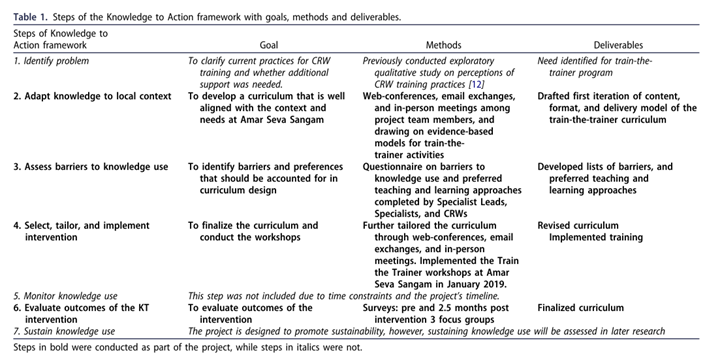Assessing community needs
Evidence Based Research shows that successful CBR training starts with a community needs assessment, done with the community benefiting from the training. This determines the communities needs, as well as barriers and enhancers to the training.
(below is based on Kester et al.Kester ACM, Kaelin VC. Participatory capacity development: Report of a community-based training needs assessment in Vietnam. World Federation of Occupational Therapists Bulletin. 2021;77(1):40-8)
Starting point demand
Initial information gathering
1
 Verify demand and client commitment
Verify demand and client commitment-
 Identify root of problem
Identify root of problem
2
 Identify key stakeholders
Identify key stakeholders-
 Internal (client)
Internal (client) -
 External
External
3
 Identify desired capacity
Identify desired capacity
4
 Identify current capacity
Identify current capacity
5
 From current to desired capacity
From current to desired capacity-
 Discuss and prioritise with client
Discuss and prioritise with client
6
 Can training contribute?
Can training contribute?
7
 Specify training needs
Specify training needs
-
 What, how and whom to train?
What, how and whom to train?
-
 Barriers and enhancers to transfer of learning
Barriers and enhancers to transfer of learning
Below graphic designed by: Hunt M, Ponnusamy R, Goulet A, Anthonypillai C, Muthukaruppan SS, Bharathwaj A, et al. An integrated knowledge translation project to develop, implement, and evaluate a train-the-trainer program at a community rehabilitation program in Tamil Nadu, India. Disabil Rehabil. 2021;43(26):3868-77.

(...and an edited option)
All modules are written and proofed by highly experienced senior physios who have collaborated with health workers in many global health backgrounds.
Our ten key conditions to all modules are to:
- deliver essential practice
- include clinical reasoning and differential diagnosis
- emphasise intuitive comprehension
- translate into any language
- be safe through clinical trialling
- be culturally sensitive
- include anatomy, physiology and pathology
- guide the student safely through all stages
- allow flexible lesson planning with cut and paste options
- be simple to learn with long term practical uses
We hope you will agree! Yet it is important to add that these modules should only be taught by qualified physios so that instruction is kept simple and rehab needs are properly provided to communities that are without current access to physio services.